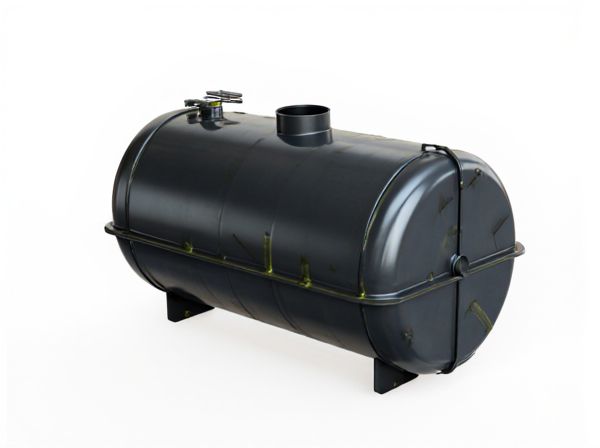
Photo illustration: Toroidal Tank vs Cylindrical Tank
A toroidal tank offers compact storage by utilizing a donut-shaped design that fits efficiently in limited spaces, making it ideal for applications like fuel storage on aircraft or vehicles. Cylindrical tanks provide simpler construction and maintenance with evenly distributed stress along their walls, which enhances their structural integrity for large-scale liquid storage. Your choice depends on space constraints and specific use cases, with toroidal tanks excelling in space-saving and cylindrical tanks favored for ease of manufacturing and high volume capacity.
Table of Comparison
| Feature | Toroidal Tank | Cylindrical Tank |
|---|---|---|
| Shape | Donut-shaped, fits in spare tire well | Standard cylinder, bulky footprint |
| Space Efficiency | High, uses spare tire space | Lower, occupies trunk space |
| Fuel Capacity | Moderate (20-25 liters) | Varies widely (30+ liters) |
| Installation | Complex due to shape | Simple, standard mounting |
| Weight Distribution | Balanced under vehicle floor | May affect trunk balance |
| Cost | Higher due to design | Lower, mass-produced |
| Durability | Good, resistant to impacts | Good, depends on material |
| Usage | Common in compact and hybrid cars | Standard in most vehicles |
Introduction to Tank Geometries
Toroidal tanks feature a doughnut-shaped geometry, providing enhanced space utilization and structural integrity often preferred in aerospace and automotive fuel storage. Cylindrical tanks, with their simple round cross-section and straightforward fabrication, are widely used in industrial and residential applications due to their cost-effectiveness and ease of manufacture. Comparing volume efficiency and stress distribution reveals that toroidal tanks excel in compact installations, whereas cylindrical tanks offer versatility and ease of maintenance.
Overview of Toroidal Tanks
Toroidal tanks are donut-shaped fuel containers commonly used in automotive and aerospace applications due to their compact, space-efficient design that fits around vehicle components like spare tires. Their shape helps lower the center of gravity, enhancing stability and handling compared to traditional cylindrical tanks. These tanks offer improved volume utilization within confined spaces, making them ideal for maximizing fuel capacity without compromising design constraints.
Overview of Cylindrical Tanks
Cylindrical tanks feature a uniform circular cross-section, providing structural stability and ease of fabrication for storing liquids and gases. These tanks are widely used in industries such as water treatment, petrochemical storage, and agriculture due to their efficient volume-to-surface area ratio and straightforward installation. Their design facilitates pressure distribution and maintenance, making them a cost-effective solution for large-capacity storage needs.
Space Utilization and Footprint
Toroidal tanks offer superior space utilization in confined areas due to their ring-shaped design, allowing for installation around central components and reducing dead space compared to cylindrical tanks. Cylindrical tanks require a larger footprint because of their vertical or horizontal orientation and straight walls, which limit placement flexibility in tight environments. Optimizing footprint efficiency is critical in applications like aerospace and automotive industries where maximizing usable volume within minimal space is essential.
Structural Strength and Integrity
Toroidal tanks exhibit superior structural strength due to their curved geometry, which evenly distributes stress and minimizes weak points, making them highly resistant to deformation under pressure. Cylindrical tanks, while straightforward in design, experience higher stress concentration along their straight walls and flat end caps, necessitating thicker materials or reinforcements to maintain integrity. Engineers often prefer toroidal tanks in high-pressure applications and environments requiring enhanced durability and fatigue resistance.
Manufacturing Complexity and Costs
Toroidal tanks exhibit higher manufacturing complexity due to their curved geometry, requiring specialized welding techniques and custom tooling that increase fabrication time and labor costs. Cylindrical tanks benefit from standardized production processes with simpler shapes, resulting in lower material waste and reduced assembly expenses. The intricate design of toroidal tanks often leads to significant cost premiums compared to the more economical and straightforward cylindrical tank construction.
Fluid Dynamics and Mixing Efficiency
Toroidal tanks offer superior fluid dynamics by promoting continuous swirling motion, which enhances mixing efficiency and reduces dead zones compared to cylindrical tanks. The curved geometry in toroidal tanks creates a vortex flow pattern that improves the homogeneity of fluid mixtures and accelerates heat transfer processes. Cylindrical tanks often experience stratification and slower mixing rates due to their linear flow paths and limited turbulence generation.
Maintenance and Accessibility
Toroidal tanks offer easier access for maintenance due to their compact design and modular sections, allowing for quicker inspection and repair. Cylindrical tanks often require more time-consuming procedures to reach internal components because of their larger size and uniform shape. Maintenance costs for toroidal tanks tend to be lower as accessibility reduces labor intensity and downtime.
Ideal Applications for Each Tank Type
Toroidal tanks are ideal for aircraft and automotive fuel storage due to their compact, space-saving design that fits well in confined spaces like wheel wells. Cylindrical tanks excel in industrial and agricultural applications, providing efficient volume-to-surface-area ratio for water, chemicals, or fuel storage with easier manufacturing and maintenance. Each tank type offers unique advantages tailored to specific spatial constraints and operational requirements.
Conclusion: Choosing the Right Tank Geometry
Toroidal tanks provide efficient space utilization and improved stability, making them ideal for applications requiring compact design and lower center of gravity. Cylindrical tanks offer simpler construction, easier maintenance, and better suitability for large-scale storage due to their uniform stress distribution and cost-effectiveness. Selecting the right tank geometry depends on specific needs such as spatial constraints, structural requirements, and budget considerations.
 caratoz.com
caratoz.com